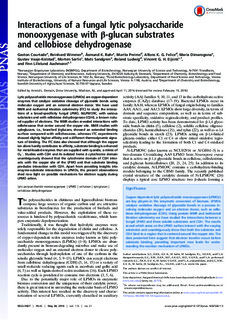| dc.contributor.author | Courtade, Gaston | |
| dc.contributor.author | Wimmer, Reinhard | |
| dc.contributor.author | Kjendseth, Åsmund Røhr | |
| dc.contributor.author | Preims, Marita | |
| dc.contributor.author | Felice, Alfons K.G. | |
| dc.contributor.author | Dimarogona, Maria | |
| dc.contributor.author | Vaaje-Kolstad, Gustav | |
| dc.contributor.author | Sørlie, Morten | |
| dc.contributor.author | Sandgren, Mats | |
| dc.contributor.author | Ludwig, Roland | |
| dc.contributor.author | Eijsink, Vincent | |
| dc.contributor.author | Aachmann, Finn Lillelund | |
| dc.date.accessioned | 2017-11-13T13:04:00Z | |
| dc.date.available | 2017-11-13T13:04:00Z | |
| dc.date.created | 2016-05-09T09:36:24Z | |
| dc.date.issued | 2016 | |
| dc.identifier.citation | Proceedings of the National Academy of Sciences of the United States of America. 2016, 113 (21), 5922-5927. | nb_NO |
| dc.identifier.issn | 0027-8424 | |
| dc.identifier.uri | http://hdl.handle.net/11250/2465839 | |
| dc.description.abstract | Lytic polysaccharide monooxygenases (LPMOs) are copper-dependent enzymes that catalyze oxidative cleavage of glycosidic bonds using molecular oxygen and an external electron donor. We have used NMR and isothermal titration calorimetry (ITC) to study the interactions of a broad-specificity fungal LPMO, NcLPMO9C, with various substrates and with cellobiose dehydrogenase (CDH), a known natural supplier of electrons. The NMR studies revealed interactions with cellohexaose that center around the copper site. NMR studies with xyloglucans, i.e., branched β-glucans, showed an extended binding surface compared with cellohexaose, whereas ITC experiments showed slightly higher affinity and a different thermodynamic signature of binding. The ITC data also showed that although the copper ion alone hardly contributes to affinity, substrate binding is enhanced for metal-loaded enzymes that are supplied with cyanide, a mimic of O2 −. Studies with CDH and its isolated heme b cytochrome domain unambiguously showed that the cytochrome domain of CDH interacts with the copper site of the LPMO and that substrate binding precludes interaction with CDH. Apart from providing insights into enzyme–substrate interactions in LPMOs, the present observations shed new light on possible mechanisms for electron supply during LPMO action. | nb_NO |
| dc.language.iso | eng | nb_NO |
| dc.publisher | National Academy of Sciences | nb_NO |
| dc.relation.uri | www.pnas.org/cgi/doi/10.1073/pnas.1602566113 | |
| dc.title | Interactions of a fungal lytic polysaccharide monooxygenase with β-glucan substrates and cellobiose dehydrogenase | nb_NO |
| dc.type | Journal article | nb_NO |
| dc.type | Peer reviewed | nb_NO |
| dc.description.version | publishedVersion | nb_NO |
| dc.source.pagenumber | 5922-5927 | nb_NO |
| dc.source.volume | 113 | nb_NO |
| dc.source.journal | Proceedings of the National Academy of Sciences of the United States of America | nb_NO |
| dc.source.issue | 21 | nb_NO |
| dc.identifier.doi | 10.1073/pnas.1602566113 | |
| dc.identifier.cristin | 1354463 | |
| dc.relation.project | Norges forskningsråd: 221576 | nb_NO |
| dc.relation.project | Norges forskningsråd: 226244 | nb_NO |
| dc.relation.project | Norges forskningsråd: 214613 | nb_NO |
| dc.relation.project | Norges forskningsråd: 240967 | nb_NO |
| dc.description.localcode | © 2016 The Authors. Published by National Academy of Sciences. | nb_NO |
| cristin.unitcode | 194,66,15,0 | |
| cristin.unitname | Institutt for bioteknologi og matvitenskap | |
| cristin.ispublished | true | |
| cristin.fulltext | original | |
| cristin.qualitycode | 2 | |
